The Role of Interactive Features within a Mathematics Storybook in Interpreting a Conflict and Conflict Resolution: The Case of Three Fifth Graders
Abstract
:1. Introduction
2. Cognitive Conflict and Conflict Resolution
The Case of Integers’ Order and Values
3. Mathematics Storybooks
Interactive Mathematics Storybooks
4. Present Study
4.1. Temperature Turmoil
4.2. The Study Goals
5. Methods
5.1. Participants, Setting, and Study Design
5.1.1. Pretest and Posttest
5.1.2. Intervention Sessions
5.2. Data Sources and Analysis
6. Findings
6.1. Pretest
6.2. Harry
6.2.1. Retellings
Their temperatures are different because this [Cozyland] is going up from zero and this [Icyland] is going down from zero. This [Icyland], it’s negatives and this [Cozyland] is positives. So, they think that’s the same temperature cause thirty-three positive and thirty-three negative(pp. 7–8).
6.2.2. Session Tests
6.2.3. Drawn Thermometers
This side is the positive side with kind of like the Cozyland [be]cause it added up here, and that’s the more warm side. This side is more cold side [be]cause of the negatives and below zero. Now, that sign can show you that’s [a] minus ten from zero.
6.3. Lola
6.3.1. Retellings
6.3.2. Session Tests
6.3.3. Drawn Thermometers
6.4. Claire
6.4.1. Retellings
6.4.2. Session Tests
6.4.3. Drawn Thermometers
- Researcher:
- What are these numbers that are here? [pointing to the left of Claire’s thermometer]
- Claire:
- These are hot.
- Researcher:
- What about these? [pointing to the right of Claire’s thermometer].
- Claire:
- They are negatives.
6.5. Posttest
7. Cross-Case Synthesis and Conclusion
7.1. Test Responses
7.2. Retellings and Drawn Thermometers
8. Discussion and Implications
Funding
Institutional Review Board Statement
Informed Consent Statement
Data Availability Statement
Acknowledgments
Conflicts of Interest
References
- Wessman-Enzinger, N.M.; Tobias, J.; Olanoff, D. Prospective teachers’ attention to realism and consistency with negative integers, addition, and temperature. Investig. Math. Learn. 2020, 12, 226–241. [Google Scholar] [CrossRef]
- Whitacre, I.; Bihop, J.P.; Lamb, L.L.; Philipp, R.A.; Schappelle, B.P.; Lewis, M. Integers: History, textbook approaches, and children’s productive mathematical intuitions. In Proceedings of the 33rd Annual Meeting of the North American Chapter of the International Group for the Psychology of Mathematics Education, Reno, NV, USA, 20–23 October 2011. [Google Scholar]
- Bishop, J.P.; Lamb, L.L.; Philipp, R.A.; Whitacre, I.; Schappelle, B.P. Using order to reason about negative numbers: The case of Violet. Educ. Stud. Math. 2014, 86, 39–59. [Google Scholar] [CrossRef]
- Bofferding, L. Negative integer understanding: Characterizing first graders’ mental models. J. Res. Math. Educ. 2014, 45, 194–245. [Google Scholar] [CrossRef] [Green Version]
- Bofferding, L. Understanding negative numbers. In Constructing Number: Merging Perspectives from Psychology and Mathematics Education; Norton, A., Alibali, M., Eds.; Springer Nature: Cham, Switzerland, 2019; pp. 251–277. [Google Scholar] [CrossRef]
- Bofferding, L.; Aqazade, M.; Farmer, S. Playing with integers: A quest for structure. In Exploring the Integer Addition and Subtraction Landscape; Bofferding, L., Wessman-Enzinger, N.M., Eds.; Springer International Publishing: Cham, Switzerland, 2018; pp. 3–25. [Google Scholar] [CrossRef]
- Bofferding, L.; Farmer, S. Most and least: Differences in integer comparisons based on temperature comparison language. Int. J. Sci. Math. 2019, 17, 545–563. [Google Scholar] [CrossRef]
- Nurnberger-Haag, J. Take it away or walk the other way? Finding positive solutions for integer subtraction. In Exploring the Integer Addition and Subtraction Landscape: Perspectives on Integer Thinking; Bofferding, L., Wessman-Enzinger, N.M., Eds.; Springer International Publishing: Cham, Switzerland, 2018; pp. 109–142. [Google Scholar] [CrossRef]
- Schindler, M.; Huβmann, S. About students’ individual concepts of negative integers—In terms of the order relation. In Proceedings of the Eighth Congress of the European Society for Research in Mathematics Education (CERME 8), Ankara, Turkey, 6–10 February 2013; pp. 373–382. [Google Scholar]
- Schindler, M.; Huβmann, S.; Nilsson, P.; Bakker, A. Sixth-grade students’ reasoning on the order relation of integers as influenced by prior experience: An inferentialist analysis. Math. Educ. Res. J. 2017, 29, 471–492. [Google Scholar] [CrossRef] [Green Version]
- Stephan, M.; Akyuz, D. A proposed instructional theory for integer addition and subtraction. J. Res. Math. Educ. 2012, 43, 428–464. [Google Scholar] [CrossRef] [Green Version]
- Stephan, M.; Akyuz, D. Teaching integers to students with disabilities: Three case studies. In Exploring the Integer Addition and Subtraction Landscape; Bofferding, L., Wessman-Enzinger, N.M., Eds.; Springer International Publishing: Cham, Switzerland, 2018; pp. 75–108. [Google Scholar] [CrossRef]
- Whitacre, I.; Azuz, B.; Lamb, L.; Bishop, J.S.; Philipp, R.A. Integer comparison across the grades: Students’ justifications and ways of reasoning. J. Math. Behav. 2017, 45, 47–62. [Google Scholar] [CrossRef] [Green Version]
- Piaget, J. The Origins of Intelligence in Children; International Universities Press: London, UK, 1952. [Google Scholar]
- Piaget, J. Piaget’s Theory. The Equilibration of Cognitive Structures: The Central Problem of Intellectual Development; University of Chicago Press: Chicago, IL, USA, 1985. [Google Scholar]
- Bofferding, L. Temperature Turmoil, 1st ed.; Purdue University: West Lafayette, IN, USA, 2021. [Google Scholar]
- Bofferding, L.; (Department of Curriculum and Instruction, College of Education, Purdue University, West Lafayette, IN, USA); Wessman-Enzinger, N.M.; (School of Education, George Fox University, Newberg, OR, USA). Recent survey of how teachers introduce negative numbers to students. Personal communication, 2021. [Google Scholar]
- National Council of Teachers of Mathematics. Principles and Standards for School Mathematics; National Council of Teachers of Mathematics: Reston, VA, USA, 2000. [Google Scholar]
- National Governors Association Center for Best Practices; Council of Chief State School Officers. Common Core State Standards for Mathematics. Washington, DC, USA, 2000. Available online: http://www.corestandards.org/assets/CCSSI_Math%20Standards.pdf (accessed on 5 April 2019).
- Wessman-Enzinger, N.M.; Mooney, E.S. Conceptual models for integer addition and subtraction. Int. J. Math. Educ. Sci. Technol. 2019, 52, 349–376. [Google Scholar] [CrossRef]
- Gallardo, A. The extension of the natural-number domain to the integers in the transitions from arithmetic to algebra. Educ. Stud. Math. 2002, 49, 171–192. [Google Scholar] [CrossRef]
- Altiparmak, K.; Özdoğan, E. A study on the teaching of the concept of negative numbers. Int. J. Math. Educ. Sci. Technol. 2010, 41, 31–47. [Google Scholar] [CrossRef]
- Wessman-Enzinger, N.M.; Tobias, J.M. The dimensions of prospective elementary and middle school teachers’ problem posing for integer addition and subtraction. J. Math. Teach. Educ. 2020, 1–33. [Google Scholar] [CrossRef]
- Schwarz, B.B.; Kohn, A.S.; Resnick, L.B. Positives about negatives: A case study of an intermediate model for signed numbers. J. Learn. Sci. 1993, 3, 37–92. [Google Scholar] [CrossRef]
- Yin, R.K. Case Study Research and Applications: Design and Methods, 6th ed.; Sage: Los Angeles, CA, USA, 2018. [Google Scholar]
- Limón, M. On the cognitive conflict as an instructional strategy for conceptual change: A critical appraisal. Learn. Instr. 2001, 11, 357–380. [Google Scholar] [CrossRef]
- Shahbari, J.A.; Peled, I. Resolving cognitive conflict in a realistic situation with modeling characteristics: Coping with a changing reference in fractions. Int. J. Sci. Math. 2015, 13, 891–907. [Google Scholar] [CrossRef]
- Zazkis, R.; Chernoff, E.J. What makes a counterexample exemplary? Educ. Stud. Math. 2008, 68, 195–208. [Google Scholar] [CrossRef]
- Gal, H. When the use of cognitive conflict is ineffective—Problematic learning situations in geometry. Educ. Stud. Math. 2019, 102, 239–256. [Google Scholar] [CrossRef]
- Watson, J.M. Inferential reasoning and the influence of cognitive conflict. Educ. Stud. Math. 2002, 51, 225–256. [Google Scholar] [CrossRef]
- Watson, J.M. The role of cognitive conflict in developing students’ understanding of average. Educ. Stud. Math. 2007, 65, 21–47. [Google Scholar] [CrossRef]
- Zaslavsky, O. Seizing the opportunity to create uncertainty in learning mathematics. Educ. Stud. Math. 2005, 60, 297–321. [Google Scholar] [CrossRef]
- Chan, C.; Burtis, J.; Bereiter, C. Knowledge building as a mediator of conflict in conceptual change. Cogn. Instr. 1997, 151, 1–40. [Google Scholar] [CrossRef] [Green Version]
- D’Ambrosio, B.S.; Mendonça Campos, T.M. Pre-service teachers’ representations of children’s understanding of mathematical concepts: Conflicts and conflict resolution. Educ. Stud. Math. 1992, 23, 213–230. [Google Scholar] [CrossRef]
- Schunk, D. Learning Theories: An Educational Perspective, 6th ed.; Pearson Education: Boston, MA, USA, 2012. [Google Scholar]
- Chen, L.; Bofferding, L.; Aqazade, M. Comparison with closest and most: Second and fifth graders’ conceptions of integer value. In Proceedings of the 40th Annual Meeting of the North American Chapter of the International Group for the Psychology of Mathematics Education, Greenville, SC, USA, 15–18 November 2018; pp. 187–191. [Google Scholar]
- Swanson, P.E. The intersection of language and mathematics. Math. Teach. Middle Sch. 2010, 15, 516–523. [Google Scholar] [CrossRef]
- Whitacre, I.; Bishop, J.P.; Philipp, R.A.; Lamb, L.L.; Schappelle, B.P. Dollars and sense: Students’ integer perspectives. Math. Teach. Middle Sch. 2014, 20, 84–89. [Google Scholar] [CrossRef]
- Thompson, P.W.; Dreyfus, T. Integers as transformations. J. Res. Math. Educ. 1988, 19, 115–133. [Google Scholar] [CrossRef]
- Wessman-Enzinger, N.M. Integer Numbers and Temperature Problems. Math. Teach. Middle Sch. 2019, 24, 266–272. [Google Scholar] [CrossRef]
- Wessman-Enzinger, N.M. Integers as directed quantities. In Constructing Number: Merging Perspectives from Psychology and Mathematics Education; Norton, A., Alibali, M., Eds.; Springer Nature: Cham, Switzerland, 2019; pp. 279–305. [Google Scholar] [CrossRef]
- Wessman-Enzinger, N.M.; Mooney, E.S. Making sense of integers through storytelling. Math. Teach. Middle Sch. 2014, 20, 202–205. [Google Scholar] [CrossRef]
- Aqazade, M. The Roles of Interactive Features, Language, Context, and Stories in Students’ Conceptions of Integers. Ph.D. Thesis, Purdue University, West Lafayette, IN, USA, August 2021. [Google Scholar]
- Aqazade, M. Exhibiting integers’ conflict and resolution using a mathematics storybook: The case of four fifth graders. In Proceedings of the 43rd Annual Meeting of the North American Chapter of the International Group for the Psychology of Mathematics Education, Philadelphia, PA, USA, 14–17 October 2021; pp. 318–322. [Google Scholar]
- Vlassis, J. Making sense of the minus sign or becoming flexible in ‘negativity’. Learn. Instr. 2004, 14, 469–484. [Google Scholar] [CrossRef]
- Vlassis, J. The role of mathematical symbols in the development of number conceptualization: The case of the minus sign. Philos. Psychol. 2008, 21, 555–570. [Google Scholar] [CrossRef]
- Aqazade, M.; Bofferding, L.; Farmer, S. Benefits of analyzing contrasting integer problems: The case of four second graders. In Proceedings of the 38th Annual Meeting of the North American Chapter of the International Group for the Psychology of Mathematics Education, Tucson, AZ, USA, 3–6 November 2016; pp. 132–139. [Google Scholar]
- Bofferding, L.; Aqazade, M.; Farmer, S. Second graders’ integer addition understanding: Leveraging contrasting cases. In Proceedings of the 39th Annual Meeting of the North American Chapter of the International Group for the Psychology of Mathematics Education, Indianapolis, IN, USA, 5–8 October 2017; pp. 243–250. [Google Scholar]
- Ball, D.L. With an eye on the mathematical horizon: Dilemmas of teaching elementary school mathematics. Elem. Sch. J. 1993, 93, 373–397. [Google Scholar] [CrossRef] [Green Version]
- Piaget, J. The Child’s Conception of Number; Routledge & Kegan Paul, Ltd.: London, UK, 1952. [Google Scholar]
- Capraro, R.M.; Capraro, M.M. Are you really going to read us a story? Learning geometry through children’s mathematics literature. Read. Psychol. 2006, 27, 21–36. [Google Scholar] [CrossRef]
- Hassinger-Das, B.; Jordan, N.C.; Dyson, N. Reading stories to learn math: Mathematics vocabulary instruction for children with early numeracy difficulties. Elem. Sch. J. 2015, 116, 242–264. [Google Scholar] [CrossRef] [Green Version]
- Jennings, C.M.; James, J.; Richey, J.; Dixon-Krauss, L. Increasing interest and achievement in mathematics through children’s literature. Early Child. Res. Q. 1992, 7, 263–276. [Google Scholar] [CrossRef]
- van den Heuvel-Panhuizen, M.; Elia, I.; Robitzsch, A. Effects of reading picture books on kindergartners’ mathematics performance. J. Educ. Psychol. 2016, 36, 323–346. [Google Scholar] [CrossRef] [PubMed] [Green Version]
- Segal-Drori, O.; Kalmanovich, L.B.H.; Shamir, A. Electronic book for promoting emergent math: A comparison between kindergarteners at risk for learning disabilities and with typical development. J. Educ. Comput. 2019, 57, 954–977. [Google Scholar] [CrossRef]
- Ginsburg, H.P.; Uscianowski, C.; Almeda, V.M. Interactive mathematics storybooks and their friends. In Contemporary Research and Perspectives on Early Childhood Mathematics Education, ICME-13 Monographs; Mulligan, E.J., Anderson, A., Baccaglini-Frank, A., Benz, C., Eds.; Springer International Publishing: Cham, Switzerland, 2018; pp. 245–263. [Google Scholar]
- Bus, A.G.; Takacs, Z.K.; Kegel, C.A.T. Affordances and limitations of electronic storybooks for young children’s emergent literacy. Dev. Rev. 2015, 35, 79–97. [Google Scholar] [CrossRef]
- De Jong, M.T.; Bus, A.G. Quality of book-reading matters for emergent readers: An experiment with the same book in a regular or electronic format. J. Educ. Psychol. 2002, 94, 145–155. [Google Scholar] [CrossRef]
- De Jong, M.T.; Bus, A.G. How well situated are electronic books to supporting literacy? J. Early Child. Lit. 2003, 3, 147–164. [Google Scholar] [CrossRef]
- De Jong, M.T.; Bus, A.G. The efficacy of electronic books in fostering kindergarten children’s emergent story understanding. Read. Res. Q. 2004, 39, 378–393. [Google Scholar] [CrossRef]
- Guernsey, L.; Levine, M.; Chiong, C.; Severns, M. Pioneering Literacy in the Digital Wild West: Empowering Parents and Educators; Joan Ganz Cooney Center: New York, NY, USA, 2012; Available online: http://joanganzcooneycenter.org/publication/pioneering-literacy/ (accessed on 3 March 2019).
- Korat, O.; Shamir, A. Do Hebrew electronic books differ from Dutch electronic books? A replication of Dutch content analysis. J. Comput. Assist. 2004, 20, 257–268. [Google Scholar] [CrossRef]
- Smeets, D.J.; Bus, A.G. The interactive animated e-book as a word learning device for kindergarteners. Appl. Psycholinguist. 2015, 36, 899–920. [Google Scholar] [CrossRef] [Green Version]
- Kucirkova, N. An integrative framework for studying, designing and conceptualising interactivity in children’s digital books. Br. Educ. Res. J. 2017, 43, 1168–1185. [Google Scholar] [CrossRef]
- Takacs, Z.K.; Swart, E.K.; Bus, A.G. Benefits and pitfalls of multimedia and interactive features in technology-enhanced storybooks: A meta-analysis. Rev. Educ. Res. 2015, 85, 698–739. [Google Scholar] [CrossRef] [PubMed] [Green Version]
- Zipke, M. Preschoolers explore interactive storybook apps: The effect on word recognition and story comprehension. Educ. Inf. Technol. 2017, 22, 1695–1712. [Google Scholar] [CrossRef]
- Uscianowski, C.; Almeda, V.; Ginsburg, H. Interactive digital storybooks and the role of parents in supporting young children’s mathematics development. In Promising Practices for Engaging Families in STEM Learning; Caspe, M., Woods, T., Lorenzo Kennedy, J., Eds.; Information Age: Charlotte, NC, USA, 2018; pp. 113–131. [Google Scholar]
- Bruno, A.; Martinon, A. The teaching of numerical extensions: The case of negative numbers. Int. J. Math. Educ. Sci. Technol. 1999, 30, 789–809. [Google Scholar] [CrossRef]
- Lysaker, J.; Nie, A.Y. Social and relational aspects of comprehending in one fourth grader’s unaided and illustration-aided picturebook retellings: Retelling as co-authoring. J. Lit. Res. 2017, 49, 38–67. [Google Scholar] [CrossRef]
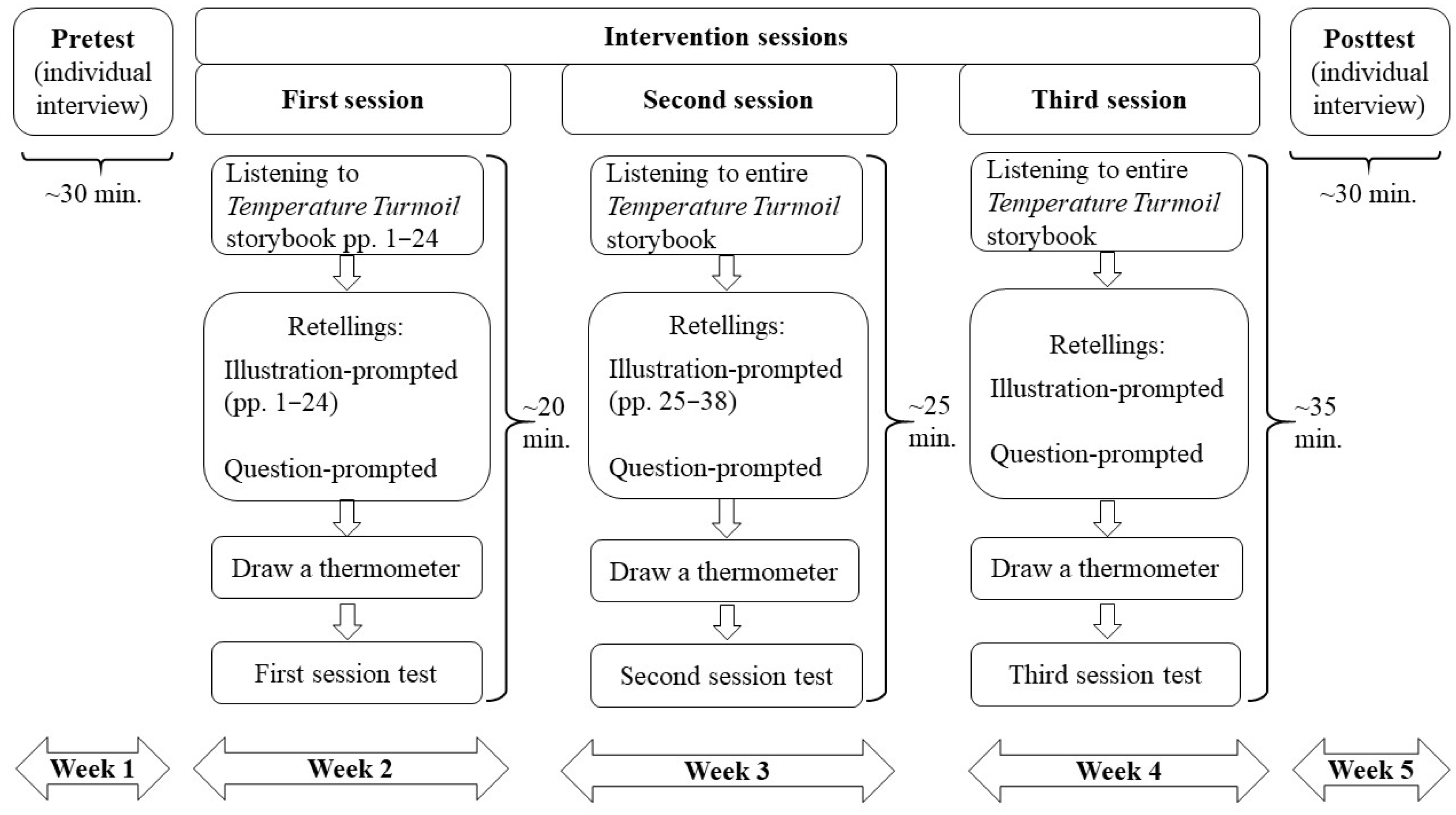
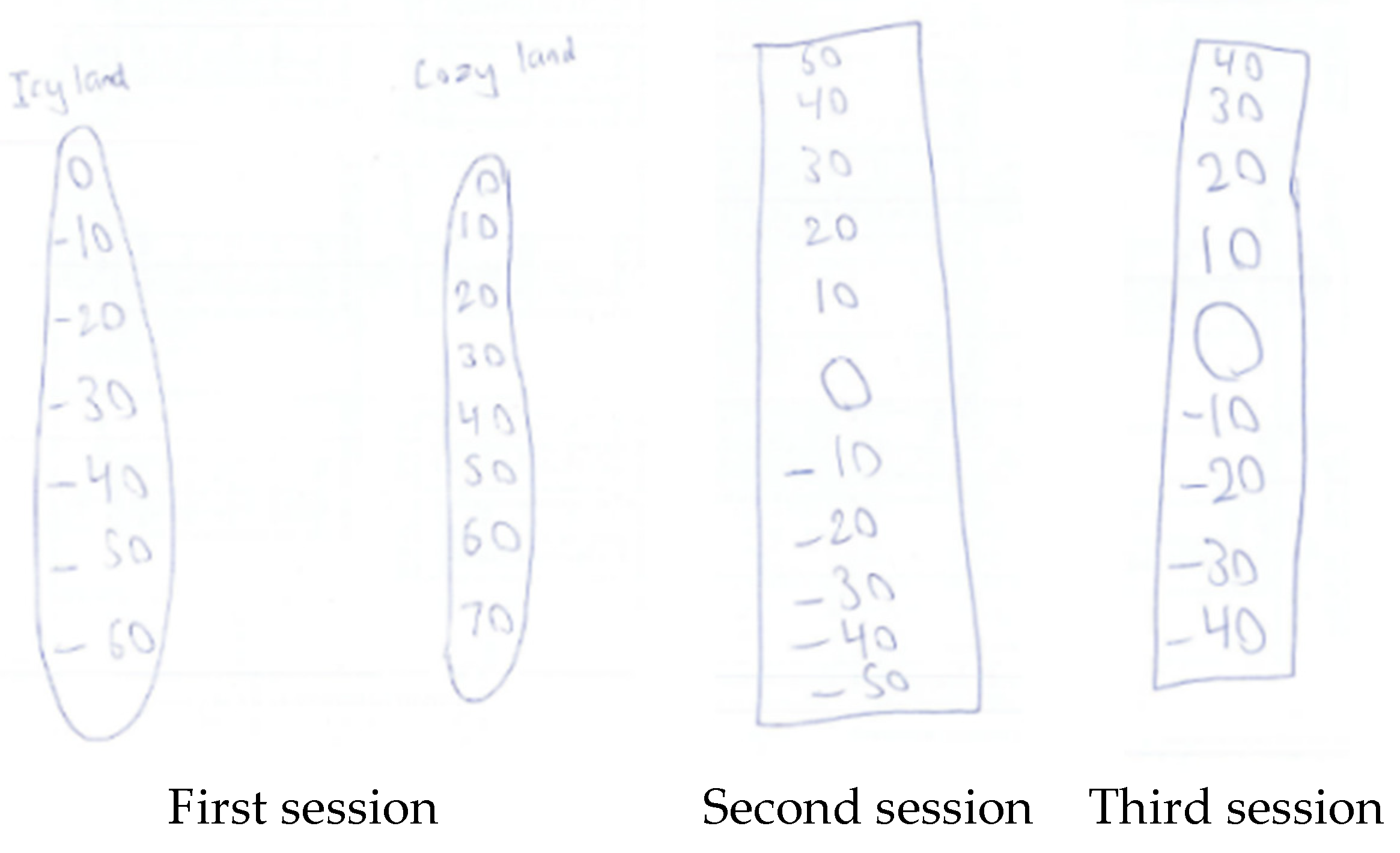

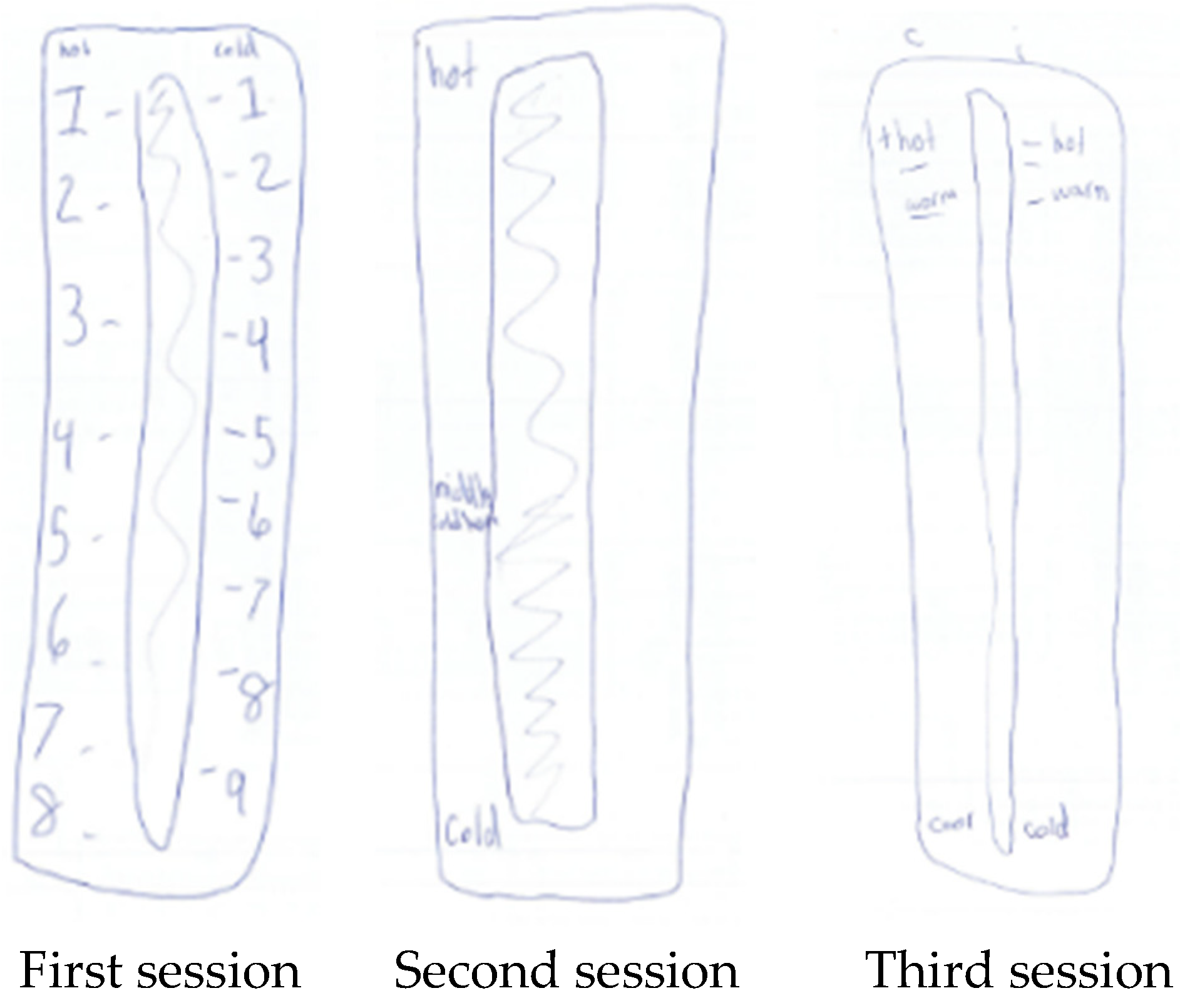
| Hotspots | Descriptions | Examples of Interactive Language | Examples of Interactive Visual | |
|---|---|---|---|---|
| Mathematical Question | Feedback | |||
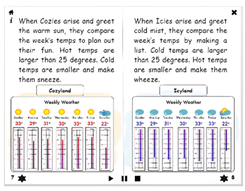 | Each thermometer is a hotspot. Thus, a total of 14 hotspots is on these two pages. | In Cozyland, which day’s temperature is smaller than Monday’s? (Choosing among six weekdays’ temperatures) | Correct answer: Yes. In Cozyland, Friday’s temperature is smaller than Monday’s temperature. | Showing a magnified thermometer. |
| Incorrect answer: No. In Cozyland, Wednesday’s temperature is larger than Monday’s temperature. | ||||
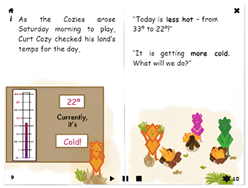 | Each sentence on page 10 is a hotspot. Additionally, less hot and more cold are bolded to re-emphasize the hotspots. Thus, there are two hotspots on this page. | In Cozyland, which temp is less hot? 33° or 22°? (Choosing between 33° and 22°) | Correct answer: Yes. In Cozyland, 22° is less hot than 33°. | Less hot hotspot: Showing an animation of the temperature change from 33 to 22. |
| Incorrect answer: No. In Cozyland, 33° is more hot than 22°. | More cold hotspot: Showing a thermometer slider to drag and see numbers on the thermometer and background view change. | |||
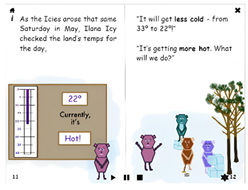 | Each sentence on page 12 is a hotspot. Additionally, less cold and more hot are bolded to re-emphasize the hotspots. Thus, there are two hotspots on this page. | In Icyland, which temp is less cold? 33° or 22°? (Choosing between 33° and 22°) | Correct answer: Yes. In Icyland, 22° is less cold than 33°. | See above. |
| Incorrect answer: No. In Icyland, 33° is more cold than 22°. | ||||
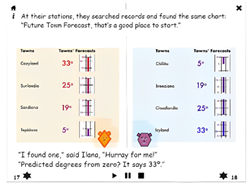 | Each town is a hotspot. Thus, a total of eight hotspots are on these two pages. | Which town’s temperature is the opposite of Chilito? (Choosing among seven towns’ temperatures) | Correct answer: Yes. Tepidona’s temperature is the opposite of Chilito’s temperature. | Showing a complete thermometer of the clicked town with a thermometer of the town that shows the opposite temperature. |
| Incorrect answer: No. Sunlandia’s temperature is the opposite of Cloudlandia’s temperature. | ||||
 | The two bubble speeches are hotspots on page 26. Additionally, more cold and more hot are bolded to re-emphasize the hotspots. | For Cozies, which 30° is more cold? (choosing between two opposite thermometers, one showing 0 down to 30 and one showing 0 up to 30) | Incorrect answer: No. If you are in Cozyland, moving away from 0° makes temperatures more hot and if you are in Icyland, moving towards 0° makes temperatures more hot. | Showing two towns’ thermometers side-by-side. |
| Incorrect answer: No. If you are in Cozyland, moving away from 0° makes temperatures more hot and if you are in Icyland, moving towards 0° makes temperatures more hot. | ||||
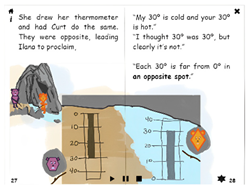 | The sentence, “Each 30 is far from 0 in an opposite spot”, on page 28 is the hotspot. Additionally, an opposite spot is bolded to re-emphasize the hotspot. | What is the opposite of 30° from Icyland? (Choosing among four thermometers: showing 0 to 25 upward, 0 to 20 downward, 0 to 25 downward, 0 to 30 upward, 0 to 20 upward) | Correct answer: Yes. The opposite of 30° from Icyland is 30° from Cozyland. | Showing two towns opposite thermometers side-by-side. |
| Incorrect answer: No. 25° from Cozyland is the opposite of 25° from Icyland. | ||||
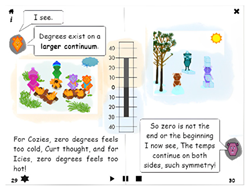 | The sentence, “Degrees exist on a larger continuum”, in page 29 is the hotspot. Additionally, a larger continuum is bolded to re-emphasize the hotspot. | On a larger continuum, choose the opposite of 30° from Cozyland. (Choosing among 20 and 10 above 0 and 10, 20, and 30 below 0) | Correct answer: 30° from Icyland is the opposite of 30° from Cozyland. | Showing an animation of temperature changing of two opposite thermometers side-by-side. |
| Incorrect answer: No. 20° from Cozyland is the opposite of 20° from Icyland. | ||||
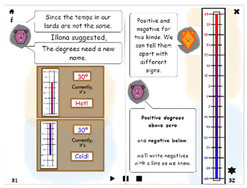 | Two sentences, “positive degrees above zero” and “negative below” on page 32 are two hotspots. Additionally, positive degrees above zero and negative below are bolded to re-emphasize the hotspots. | Which temperatures are positive numbers? (Choosing among −20°, −30°, 15°, 25°, −25°, 20°) | Correct answer: Yes. 15, 20, and 25 are positive numbers. | Showing an animation of temperature changing on a single thermometer from positive to negative. |
| Incorrect answer: No. Positive numbers are above zero and do not have a line. | ||||
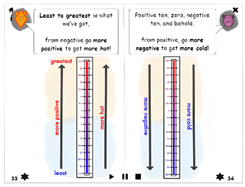 | Three sentences, “Least to greatest is what we’ve got”, “from negative go more positive to ger more hot!”, and “positive ten, zero, negative ten, and behold, from positive go more negative to get more cold” across both pages are three hotspots. Additionally, least to greatest, more positive, more hot, more negative, and more cold are bolded to re-emphasize the hotspots. | Which of the temperatures are correctly ordered from least to greatest? (Choosing (a) −15°, −25°, −35°, 0°, 10°, 25°, 30°, (b) −35°, −25°, −15°, 0°, 10°, 25°, 30°, and (c) 0°, 10°, −15°, −25°, 25°, 30°, −35°) | Correct answer: Yes. −35°, −25°, −15°, 0°, 10°, 25°, 30° shows least to greatest temperatures. | Showing a thermometer slider to drag and see temperature comparison to 30° (e.g., 5° is more negative than 30°) |
| Incorrect answers: No. Negative numbers are below zero and positive numbers are above zero (if choose (c)) | ||||
| No. Negative and positive numbers are on opposite sides such symmetry (if choose (a)). | ||||
| Order and Value Questions | Reference(s) | ||
|---|---|---|---|
| Filling the numbers (2 items) |  | [4,6] | |
| Ordering integers (2 items) | Put these temperatures in order from least to greatest: −12, 20, 29, −35, −20, 0, 16 | [4,24] | |
| Integer comparison a (48 items) | 12 items | What does most hot mean to you? Circle the temperature that is most hot: −16, 24, −28, none | [7,13] |
| 12 items | What does most cold mean to you? Circle the temperature that is most cold: −22, 33, −26, none | ||
| 12 items | What does least cold mean to you? Circle the temperature that is least cold: −22, 18, 27, none | ||
| 12 items | What does least hot mean to you? Circle the temperature that is least hot: −31, −28, 23, none | ||
| Categories | Description | Example(s) | |
|---|---|---|---|
| Conflict | Mathematical | Referring to how the story’s characters relied on only temperatures’ absolute values or discarded their directed values. | One land’s temperature was above 0 and one land’s temperature was below 0. |
| The people of the two lands used different numbers. | |||
| Non-mathematical | Referring to how the story’s characters felt about their lands’ temperatures or describing how the change in their land’s temperature made them feel. | There are two lands: hot and cold lands, and they do not like them. | |
| Conflict resolution | Mathematical | Referring to how the story’s characters realized the differences in their temperatures or attempted to distinguish them in some way. | They will use positive and negative numbers to see the difference. |
| They will use a new thermometer. | |||
| Non-mathematical | Referring to how the story’s characters went back to their lands or adjusted to the temperature change. | They will switch lands. | |
| They will get used to being cold and hot. | |||
| Most Hot Temperature | ||||||||||||
| All positive or zero a | All negative or zero b | Mixed numbers c | ||||||||||
| Items | 22 | 26 | 21 | −25 | −21 | 0 | −16 | −31 | −22 | −24 | −29 | −11 |
| 31 | 33 | 0 | −31 | −24 | −29 | 24 | 23 | 18 | −30 | −32 | 15 | |
| 16 | 20 | 25 | −17 | −14 | −23 | 28 | 19 | 27 | 34 | 26 | −18 | |
| none | none | none | none | none | none | none | none | none | none | none | none | |
| Harry | 31 | 33 | 25 | none | none | none | none | none | none | 34 | none | none |
| Lola | 31 | 33 | 25 | −25 | −14 | −23 | 28 | 23 | 27 | 34 | 26 | 15 |
| Claire | 31 | 33 | 25 | −17 | −14 | 0 | 28 | 23 | 27 | 34 | 26 | 15 |
| Least Cold Temperature | ||||||||||||
| All positive or zero a | All negative or zero b | Mixed numbers c | ||||||||||
| Items | 22 | 26 | 21 | −25 | −21 | 0 | −16 | −31 | −22 | −24 | −29 | −11 |
| 31 | 33 | 0 | −31 | −24 | −29 | 24 | 23 | 18 | −30 | −32 | 15 | |
| 16 | 20 | 25 | −17 | −14 | −23 | 28 | 19 | 27 | 34 | 26 | −18 | |
| none | none | none | none | none | none | none | none | none | none | none | none | |
| Harry | 31 | 33 | 25 | −17 | −14 | 0 | 28 | 23 | 27 | 34 | 26 | 15 |
| Lola | 22 | 33 | 25 | −17 | −14 | 0 | 28 | 23 | 27 | 34 | −32 | 15 |
| Claire | 16 | 20 | 0 | −17 | −14 | −29 | −16 | −31 | −22 | −30 | −32 | −18 |
| Most Cold Temperature | ||||||||||||
| All positive or zero a | All negative or zero b | Mixed numbers c | ||||||||||
| Items | 20 | 22 | 0 | −11 | −33 | −17 | −13 | 15 | −19 | −22 | −31 | −12 |
| 17 | 33 | 15 | −24 | −18 | 0 | 21 | −27 | 14 | −26 | 23 | 19 | |
| 28 | 19 | 21 | −16 | −22 | −30 | 18 | 10 | 26 | 33 | −28 | −20 | |
| none | none | none | none | none | none | none | none | none | none | none | none | |
| Harry | 17 | 19 | 0 | −24 | −33 | −30 | −13 | −27 | −19 | −26 | −31 | −20 |
| Lola | 17 | 19 | 0 | −11 | −18 | −17 | 18 | −27 | 14 | −22 | −28 | −12 |
| Claire | 17 | 19 | 0 | −24 | −33 | −30 | −13 | −27 | −19 | −22 | −31 | −20 |
| Least Hot Temperature | ||||||||||||
| All positive or zero a | All negative or zero b | Mixed numbers c | ||||||||||
| Items | 20 | 22 | 0 | −11 | −33 | −17 | −13 | 15 | −19 | −22 | −31 | −12 |
| 17 | 33 | 15 | −24 | −18 | 0 | 21 | −27 | 14 | −26 | 23 | 19 | |
| 28 | 19 | 21 | −16 | −22 | −30 | 18 | 10 | 26 | 33 | −28 | −20 | |
| none | none | none | none | none | none | none | none | none | none | none | none | |
| Harry | 17 | 19 | 0 | −24 | −33 | −30 | −13 | −27 | −19 | −26 | −31 | −20 |
| Lola | 17 | 19 | 15 | −24 | −33 | −30 | −13 | −27 | −19 | −26 | −31 | −20 |
| Claire | 28 | 33 | 21 | −16 | −18 | 0 | 18 | −27 | 26 | 33 | 23 | 19 |
| First Session | |||||
| Most hot | Item | 26, 33, 20, none | −21, −24, −14, none | −29, −32, 26, none | |
| Response | 20 | −24 | −32 | ||
| Least cold | Item | 26, 33, 20, none | −21, −24, −14, none | −29, −32, 26, none | |
| Response | 33 | −14 | 26 | ||
| Most cold | Item | 19, 22, 33, none | −33, −22, −18, none | −31, −28, 23, none | |
| Response | 19 | −33 | −31 | ||
| Least hot | Item | 19, 22, 33, none | −33, −22, −18, none | −31, −28, 23, none | |
| Response | 19 | −33 | −31 | ||
| Second Session | |||||
| Most hot | Item | 22, 31, 16, none | −25, −31, −17, none | −24, −30, 34, none | |
| Response | 31 | −17 | 34 | ||
| Least cold | Item | 22, 31, 16, none | −25, −31, −17, none | −24, −30, 34, none | |
| Response | 31 | −17 | 34 | ||
| Most cold | Item | 20, 28, 17, none | −16, −11, −24, none | 33, −22, −26, none | |
| Response | 17 | −24 | −26 | ||
| Least hot | Item | 20, 28, 17, none | −16, −11, −24, none | 33, −22, −26, none | |
| Response | 17 | −24 | −26 | ||
| Third Session | |||||
| Most hot | Item | −25, −12, −28, none | −32, 20, 26, none | ||
| Response | −12 | 26 | |||
| Least cold | Item | −25, −12, −28, none | −32, 20, 26, none | ||
| Response | −28 | −32 | |||
| Most cold | Item | −20, −32, −15, none | 18, −28, −25, none | ||
| Response | −32 | −28 | |||
| Least hot | Item | −20, −32, −15, none | 18, −28, −25, none | ||
| Response | −32 | −28 | |||
| First Session | |||||
| Most hot | Item | 26, 33, 20, none | −21, −24, −14, none | −29, −32, 26, none | |
| Response | 33 | −21 | 26 | ||
| Least cold | Item | 26, 33, 20, none | −21, −24, −14, none | −29, −32, 26, none | |
| Response | 20 | −24 | −32 | ||
| Most cold | Item | 19, 22, 33, none | −33, −22, −18, none | −31, −28, 23, none | |
| Response | 19 | −18 | −31 | ||
| Least hot | Item | 19, 22, 33, none | −33, −22, −18, none | −31, −28, 23, none | |
| Response | 19 | −18 | −28 | ||
| Second Session | |||||
| Most hot | Item | 22, 31, 16, none | −25, −31, −17, none | −24, −30, 34, none | |
| Response | 22 | −17 | 34 | ||
| Least cold | Item | 22, 31, 16, none | −25, −31, −17, none | −24, −30, 34, none | |
| Response | 31 | −17 | −24 | ||
| Most cold | Item | 20, 28, 17, none | −16, −11, −24, none | 33, −22, −26, none | |
| Response | 17 | −24 | −22 | ||
| Least hot | Item | 20, 28, 17, none | −16, −11, −24, none | 33, −22, −26, none | |
| Response | 17 | −24 | −26 | ||
| Third Session | |||||
| Most hot | Item | −25, −12, −28, none | −32, 20, 26, none | ||
| Response | −12 | 26 | |||
| Least cold | Item | −25, −12, −28, none | −32, 20, 26, none | ||
| Response | −12 | 26 | |||
| Most cold | Item | −20, −32, −15, none | 18, −28, −25, none | ||
| Response | −32 | −28 | |||
| Least hot | Item | −20, −32, −15, none | 18, −28, −25, none | ||
| Response | −32 | −28 | |||
| First Session | |||||
| Most hot | Item | 26, 33, 20, none | −21, −24, −14, none | −29, −32, 26, none | |
| Response | 33 | −14 | 26 | ||
| Least cold | Item | 26, 33, 20, none | −21, −24, −14, none | −29, −32, 26, none | |
| Response | 20 | −24 | −32 | ||
| Most cold | Item | 19, 22, 33, none | −33, −22, −18, none | −31, −28, 23, none | |
| Response | 19 | −22 | −28 | ||
| Least hot | Item | 19, 22, 33, none | −33, −22, −18, none | −31, −28, 23, none | |
| Response | 22 | −18 | −28 | ||
| Second Session | |||||
| Most hot | Item | 22, 31, 16, none | −25, −31, −17, none | −24, −30, 34, none | |
| Response | 22 | −25 | −24 | ||
| Least cold | Item | 22, 31, 16, none | −25, −31, −17, none | −24, −30, 34, none | |
| Response | 22 | −17 | −24 | ||
| Most cold | Item | 20, 28, 17, none | −16, −11, −24, none | 33, −22, −26, none | |
| Response | 17 | −24 | −26 | ||
| Least hot | Item | 20, 28, 17, none | −16, −11, −24, none | 33, −22, −26, none | |
| Response | 20 | −16 | −22 | ||
| Third Session | |||||
| Most hot | Item | −25, −12, −28, none | −32, 20, 26, none | ||
| Response | −12 | 26 | |||
| Least cold | Item | −25, −12, −28, none | −32, 20, 26, none | ||
| Response | −25 | 20 | |||
| Most cold | Item | −20, −32, −15, none | 18, −28, −25, none | ||
| Response | −32 | −28 | |||
| Least hot | Item | −20, −32, −15, none | 18, −28, −25, none | ||
| Response | −20 | −28 | |||
| Most Hot Temperature | ||||||||||||
| All positive or zero a | All negative or zero b | Mixed numbers c | ||||||||||
| Items | 22 | 26 | 21 | −25 | −21 | 0 | −16 | −31 | −22 | −24 | −29 | −11 |
| 31 | 33 | 0 | −31 | −24 | −29 | 24 | 23 | 18 | −30 | −32 | 15 | |
| 16 | 20 | 25 | −17 | −14 | −23 | 28 | 19 | 27 | 34 | 26 | −18 | |
| none | none | none | none | none | none | none | none | none | none | none | none | |
| Harry | 31 | 33 | 25 | −17 | −14 | 0 | 28 | 23 | 27 | 34 | 26 | 15 |
| Lola | 31 | 26 | 25 | −17 | −14 | 0 | 28 | 23 | 27 | 34 | 26 | 15 |
| Claire | 31 | 33 | 25 | −17 | −14 | 0 | 28 | 23 | 27 | 34 | 26 | 15 |
| Least Cold Temperature | ||||||||||||
| All positive or zero a | All negative or zero b | Mixed numbers c | ||||||||||
| Items | 22 | 26 | 21 | −25 | −21 | 0 | −16 | −31 | −22 | −24 | −29 | −11 |
| 31 | 33 | 0 | −31 | −24 | −29 | 24 | 23 | 18 | −30 | −32 | 15 | |
| 16 | 20 | 25 | −17 | −14 | −23 | 28 | 19 | 27 | 34 | 26 | −18 | |
| none | none | none | none | none | none | none | none | none | none | none | none | |
| Harry | 31 | 33 | 25 | −17 | −14 | 0 | 28 | 23 | 27 | 34 | 26 | 15 |
| Lola | 22 | 33 | 25 | −17 | −14 | 0 | 28 | 23 | 27 | 34 | 26 | 15 |
| Claire | 22 | 26 | 21 | −25 | −21 | −23 | 28 | 19 | 27 | −24 | −29 | 15 |
| Most Cold Temperature | ||||||||||||
| All positive or zero a | All negative or zero b | Mixed numbers c | ||||||||||
| Items | 20 | 22 | 0 | −11 | −33 | −17 | −13 | 15 | −19 | −22 | −31 | −12 |
| 17 | 33 | 15 | −24 | −18 | 0 | 21 | −27 | 14 | −26 | 23 | 19 | |
| 28 | 19 | 21 | −16 | −22 | −30 | 18 | 10 | 26 | 33 | −28 | −20 | |
| none | none | none | none | none | none | none | none | none | none | none | none | |
| Harry | 17 | 19 | 0 | −24 | −33 | −30 | −13 | −27 | −19 | −26 | −31 | −20 |
| Lola | 17 | 19 | 0 | −24 | −33 | −30 | −13 | −27 | −19 | −26 | −31 | −20 |
| Claire | 17 | 19 | 15 | −24 | −33 | −30 | −13 | −27 | −19 | −22 | −31 | −20 |
| Least Hot Temperature | ||||||||||||
| All positive or zero a | All negative or zero b | Mixed numbers c | ||||||||||
| Items | 20 | 22 | 0 | −11 | −33 | −17 | −13 | 15 | −19 | −22 | −31 | −12 |
| 17 | 33 | 15 | −24 | −18 | 0 | 21 | −27 | 14 | −26 | 23 | 19 | |
| 28 | 19 | 21 | −16 | −22 | −30 | 18 | 10 | 26 | 33 | −28 | −20 | |
| none | none | none | none | none | none | none | none | none | none | none | none | |
| Harry | 17 | 19 | 0 | −24 | −33 | −30 | −13 | −27 | −19 | −26 | −31 | −20 |
| Lola | 17 | 19 | 15 | −24 | −33 | −30 | −13 | −27 | −19 | −26 | −31 | −12 |
| Claire | 20 | 22 | 15 | −16 | −22 | −17 | 18 | 15 | 26 | −22 | −28 | −12 |
Publisher’s Note: MDPI stays neutral with regard to jurisdictional claims in published maps and institutional affiliations. |
© 2022 by the author. Licensee MDPI, Basel, Switzerland. This article is an open access article distributed under the terms and conditions of the Creative Commons Attribution (CC BY) license (https://creativecommons.org/licenses/by/4.0/).
Share and Cite
Aqazade, M. The Role of Interactive Features within a Mathematics Storybook in Interpreting a Conflict and Conflict Resolution: The Case of Three Fifth Graders. Educ. Sci. 2022, 12, 879. https://doi.org/10.3390/educsci12120879
Aqazade M. The Role of Interactive Features within a Mathematics Storybook in Interpreting a Conflict and Conflict Resolution: The Case of Three Fifth Graders. Education Sciences. 2022; 12(12):879. https://doi.org/10.3390/educsci12120879
Chicago/Turabian StyleAqazade, Mahtob. 2022. "The Role of Interactive Features within a Mathematics Storybook in Interpreting a Conflict and Conflict Resolution: The Case of Three Fifth Graders" Education Sciences 12, no. 12: 879. https://doi.org/10.3390/educsci12120879
APA StyleAqazade, M. (2022). The Role of Interactive Features within a Mathematics Storybook in Interpreting a Conflict and Conflict Resolution: The Case of Three Fifth Graders. Education Sciences, 12(12), 879. https://doi.org/10.3390/educsci12120879





